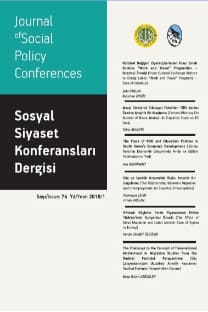FINANCIAL CRISES IN EMERGING ECONOMIES: A DESCRIPTIVE STATISTICS ANALYSIS
Bu çalışma 22 gelişmekte olan ülkede 1984 - 2001 yılları arasında meydana gelen borsa ve döviz krizlerinin zamansal ve bölgesel dağılımları ve göreceli olarak vuku bulmaları hakkında detaylı istatistiksel bilgi sağlamakta ve ayrıcada borsa ve döviz krizlerinin birbiriyle ilişkili olup olmadığını incelemektedir. Sonuçlar göstermiştir ki, borsa ve "ikiz" krizlerin sayısı ve yıllık ortalaması (frekansı) zamanla artmış (azalmış) buna karşılık döviz krizlerinin sayısı, yıllık ortalaması ve frekansı sabit kalmıştır. Ayrıca sonuçlar göstermiştir ki, borsa ve döviz krizleri genellikle eş zamanlı olarak meydana gelmektedir ve borsa krizleri azda olsa döviz krizlerinin öncü göstergesidir. Aynı zamanda, borsa krizlerinin döviz krizlerini tahmin etme gücü döviz krizlerinin borsa krizlerini tahmin etme gücünden daha yüksektir. Son olarak, borsa ve döviz krizleriyle alakalı olan kötü sinyallerin iyi sinyallere oranının 1'den az olması, borsa krizleri (döviz krizleri) olduğu zaman döviz krizlerinin (borsa krizlerinin) olma olasılığının olmama olasılığından yüksek olduğuna işaret etmektedir.
FINANCIAL CRISES IN EMERGING ECONOMIES: A DESCRIPTIVE STATISTICS ANALYSIS
This study provides a detailed statistical overview of the time and regional distribution and relative timing occurrence of stock market and currency crises in 22 emerging economies over the 1984 - 2001 periods and examines whether stock market and currency crises are related or not. We find that the number and annual average (frequency) of stock market and “twin” crises have increased (decreased) over time while the number, average per year and frequency of currency crises tends to be stable. We also find that stock market and currency crises tend to occur simultaneously and stock market crises slightly lead currency crises rather than vice-versa. At the same time, the predictive power of the stock market crises on set currency crises are higher than the predictive power of currency crises on set stock market crises. Finally, all the noise-to-signal ratios associated with stock market and currency crises are less than 1 implying that when stock market crises occur currency crises are more likely than not and vice-versa.
___
- Abdalla, I. S. A., V. Murinde (1997), “ Exchange Rate and Stock Price Interactions in Emerging Financial Markets: Evidence on India, Korea, Pakistan, and the Philippines.” Applied Financial Economics, Vol.7, pp. 25-35.
- Aggarwal, R. (1981), “Exchange Rates and Stock Prices: A Study of the US Capital Markets under Floating Exchange Rates.” Akron Business and Economic Review (Fall), Vol.12, pp. 7-12.
- Bahmani-Oskooee, M., and Sohrabian, A., (1992), “Stock Prices and the Effective Exchange Rate of the Dollar.” Applied Economics, Vol. 24, No.4, pp.459-464.
- Chen, N. F., Roll, R., and Ross, S. A. (1986), “Economic Forces and the Stock Market.” Journal of Business, Vol.59, pp. 383-403.
- Dumas, B., and B. Solnik (1995), “The World Price of Foreign Exchange Risk.” The Journal of Finance, Vol.50, no.2 (June), pp. 445-479.
- Eichengren, B., Rose, A. K. and Wyplosz, C. (1996), “Contagious Currency Crises.” NBER Working Paper, No.5681.
- Ferson, W. E., Harvey C. R. (1994), “Sources of Risk and Expected Return in Global Equity Markets.” Journal of Banking and Finance, Vol.18, pp. 775-803.
- Glick, R., Moreno, R. and Spiegel, M., M.(2001), “Financial Crises in Emerging Markets” Cambridge University Press.
- Harvey, C., R. (1995), “Predictable Risk and Return in Emerging Markets.” Review of Financial Studies, Vol.8, pp.773-816.
- Jorion, Philippe (1991), “The Pricing of Exchange Rate Risk in the Stock Market.” Journal of Financial and Quantitative Analysis, Vol. 26, no. 3 (September), pp. 363-376.
- Kaminsky, Graciela L., and Reinhart, Carmen M. (1999), “ The Twin Crises: The Cause of Banking and Balance-of-Payment Problems.” American Economic Review, June, pp. 473-500.
- Kaminsky, Graciela L., Lizondo, Saul and Reinhart, Carmen M. (1997), “Leading Indicator of Currency Crises.” Policy Research Working Paper, No. 1852, December.
- Ma, C. K., G. W. Kao (1990), “On Exchange Rate Changes and Stock Price Reactions.” Journal of Business, Finance, and Accounting, Vol.7, no.3 (Summer), pp. 441-449.
- Patel, S., and Sarkar, A. (1998), “Stock Market Crises in Developed and Emerging Markets.” Financial Analysts Journal, Vol.54, No.6, Nov/Dec, pp. 50-61.
- Smith, C. E. (1992), “Stock Market and the Exchange Rate: A Multi Country Approach.” Journal of Macroeconomics, Vol.14, no.4 (Fall), pp607-629.
- Solnik, B. H. (1987), “Using Financial Prices to Test Exchange Rate Models: A Note.” The Journal of Finance, Vol.24, no.1 (March), pp. 141-149.
- Thorbecke, Willem (1994), “ Trade Deficit News, Systematic Risk and the Crash of 1987.” Eastern Economic Journal, Vol.20 (Winter), pp. 97-114.
- ISSN: 1304-0103
- Yayın Aralığı: Yılda 2 Sayı
- Başlangıç: 1948
- Yayıncı: İstanbul Üniversitesi Yayınevi
Sayıdaki Diğer Makaleler
WOMEN’S LABOUR FORCE PARTICIPATION IN TURKEY
5272 SAYILI YASA ÖNCESİNDE TÜRKİYE'DE BELEDİYELERİN SOSYAL POLİTİKA ALANINDAKİ DENEYİMLERİ
TÜRKİYE’DE KENTSEL YOKSULLUK: KOCAELİ ÖRNEĞİ
AVUSTURYA’DA BAKIMA MUHTAÇLARIN SOSYAL GÜVENLİĞİ
BATI TÜRKİSTAN CUMHURİYETLERİ BİRLİĞİ’NİN GEREKLİLİĞİ
Salih AYNURAL, A. Kayyum KESİCİ
İDEAL BİR DİPLOMATIN (ELÇİNİN) ORTAYA ÇIKIŞI
KÜRESEL GERÇEKLERLE TÜRKİYE’DE YABANCI KAÇAK İŞ Çİ SORUNU: BOYUTLARI VE SONUÇLARI
TÜRKİYE'DEKİ DOĞRUDAN YABANCI SERMAYE YATIRIMLARININ BÜYÜMEVE İHRACATA ETKİSİ
